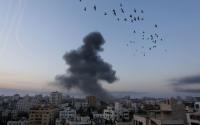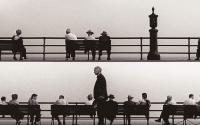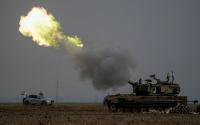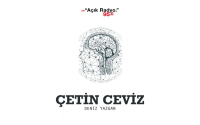On the night of August 16th, 1999, we didn’t yet know that a peaceful sleep would no more be so easy for us in the future.
A couple of hours after midnight, the tremor struck…
17 August 1999, 3:02 AM.
Those who were sleeping, those who were awake, those who were just going to bed, those who were on the road… Almost everyone living in north-western Turkey started shaking. As if by a demonic coincidence, Hindemith’s ballet piece “the Daemon” was on air at Açık Radyo at that moment. The demon burst in on our homes and was trying to suffocate us. The demon’s dance continued, continued and continued… The earthquake lasted for 45 seconds. The longest 45 seconds of the world… As if it would never come to an end… Within those 45 seconds, familiar spaces turned into coffins. They now appeared very unfamiliar. We hit the streets, we gathered in gardens, with neighbours and relatives. From our hand radios we heard people screaming for help. We were surprised, we were overwhelmed; we shivered. We didn’t yet know what had really happened.
Nothing would ever be the same again; but we didn’t know that yet. In its first news item issued 3 hours and 50 minutes after the earthquake, the Anatolia News Agency shortly said that there were three casualties. The Kandilli Observatory in İstanbul announced that the magnitude of the earthquake was 6.7. That “magnitude” rather than “intensity” was the correct scientific term, we would learn later. That morning, we also didn’t know that the earthquake would become an inevitable part-time job for all of us in the coming years.
Tuesday noon, the Kandilli Observatory corrected the magnitude as 7.4. Foreign sources said it was 7.8. We were also unable to know about the exact epicentre, but the number of casualties was more than three to be sure; much more than three. But we never knew the exact number. Although the figure announced as at least 30.000 by The Observer was never contradicted, the state and the media first agreed on 15.000 and then 18.000. Turkey had the world’s first earthquake where the number of injured decreased in time! Some time later, we learned that the government ordered 45.000 “body bags” from abroad. Based on the official figures, it turned out that they had ordered three bags per capita.
Although we never could know about the exact number of casualties, reliable sources stated that 110.000 people had been affected by the disaster. The greatest disaster of the century had also cost at least 5 billion dollars to Turkey.
People from all around the world offered a helping hand. Numerous search and rescue teams from Greece, Russia, Japan, Israel, Britain, Spain and the USA arrived at the disaster area. Turkey’s “remote neighbour” Greece suddenly came closer and became a “neighbour“. When the earthquake hit Athens three weeks later, it was our turn to help. The reciprocity was so striking that the Greek Ambassador to Turkey said that an official from the Turkish search and rescue team AKUT was the second person to call him, following his father. Meanwhile, the earthquakes physically reduced the distance between the two countries by some two centimetres.
While international civil aid was pouring into Turkey, it took the official authorities three days to reach the areas worst hit by the disaster. In other words, it was only civilians who were present in the whole area during those critical “first 72 hours”, provided, of course, that they were not sent back by the officials. During those long hours that followed the earthquake, the then President Süleyman Demirel was faced with a power cut in his home in İstanbul’s luxurious Etiler district and he couldn’t communicate with anyone. Prime Minister Ecevit was quick to send messages that “all wounds would be healed” but was not in a hurry to explain how this was to be done.
In time, people would for the first time acknowledge the scientific fact that almost the whole country was sitting on top of fault lines. President Demirel, who had previously said that the earthquake was an “act of God” would later shift his eyes from the skies towards the ground and say that “the country was resting on a cradle”. It was at the same time when we learned that there were no emergency plans for risk areas.
Thousands of people were complaining about the inertness of both civilian and military authorities and the media was talking about “official negligence”. It was not very clear how to rescue the gigantic İzmit TÜPRAŞ oil refinery which, despite all warnings, had been built right on top of the fault line many years ago and was now ablaze with 700.000 litres of oil in its storage tanks. Even after the fire was extinguished, the refinery would continue to be an environmental problem for its vicinity. In the end, a region which accounted for one third of Turkey’s industrial production was levelled off. The state, and with it, all of us, found ourselves in a hopeless situation. The seismic waves were not so strongly felt in the capital Ankara.
Life came to a stop in Turkey. Everyone was driving to the disaster area, with their cars and motorbikes filled with food and clothing. Everyone who knew how to use a shovel, an electric lamp or an injector, everyone who knew how to erect a tent, hammer a nail and dress a wound was there, like blood rushes to a wounded part of the body. A huge aid operation was launched, without waiting for the state to act. Obviously, this was an uncoordinated and unorganised civil mobilisation; almost the whole fault line was filled with bread and milk. But it was indisputable that this was the first “reverse migration” of the world. Boys with earrings and ponytails, girls with short hairs and bags, young people who for the first time saw dead bodies in their lives, worked day and night to bury decaying corpses.
The media was also on alert. Fuat Kozluklu, from NTV news channel later told that he had decided to use his projector for helping rescue operations instead of broadcasting live news. Also Açık Radyo was turned into a ‘clearing-house’ starting on the second day of the quake. The station was trying to match resources with the needs through its “Earthquake Communication Centre” established by numerous volunteers. An unlimited number of messages were arriving via phone, fax and e-mail. ARDİM (Açık Radyo Earthquake Communication Centre) later contributed to the establishment of a huge communication network together with NTV, ATV, Kanal 7 and some radio stations. The radio operated in this manner for sixty nights and days.
We would get accustomed to pictures showing bodies squeezed under the rubble, corpses carried with bulldozers, houses collapsed on other houses, lives that had collapsed on all of us, endless ruins, anxious and helpless people. We would also get accustomed to the smell -the smell of death which was in the air, on the ground and on people… Mother Nature, so many times deceived by us before, was now playing her last trick on us. Nothing would ever be the same again and we couldn’t know what to trust.
Confusion, helplessness and a sense of being left alone also caused a major psychological trauma. For example, experts said that one could not start lamenting for the lost ones, if they didn’t know where they were buried. British psychologist Lorraine Sherr says that “lamentation is an act of remembering the lost ones rather than forgetting them. For this, you have to find a starting point, a grave”. For many, such a starting point did not exist. The absence of a starting point naturally resulted in the absence of an end point. Moreover, an earthquake of such a magnitude did not seem to be a controllable disaster like a railway accident, plane crash or fire. While we could manage to find a rationale even for war casualties, the deaths caused by the splitting of the earth merely resulted in a great sense of hopelessness, a loss of self-confidence and also a loss of confidence towards nature, which we had been destroying for such a long time.
Although it caused so much agony, the 17 August earthquake also urged us to focus on weighty questions which we used to touch upon from time to time: Can there be a state in the absence of the individual? Is the state an external entity upon all of us whose acts cannot be questioned? Was it “the people for the sake of state” or “the state for the sake of the people”? It was these questions which urged us to consider the earthquake as some sort of a “turning point” which occasioned us to see life from a completely new perspective.
Notwithstanding what it said, the state was this time unable to heal all wounds with its tender hand. We were alien to the phenomenon of earthquake; we were unprepared, untrained. Ignorance, disorder, lack of organisation and cooperation were the factors that impeded the struggle for life. A news item published in the daily Milliyet last August read: “Almost all offices of the Turkish Red Crescent in Istanbul were closed on Saturday and Sunday. Citizens wishing to donate blood to the organisation were faced with closed doors”. The Turkish Red Crescent, the symbol of compassion and self sacrifice, would later be shattered by claims of gross misconduct and bad management. While hi-tec equipment were waiting in the warehouses for sale, “field tents” used in the wars of the 19th century were being sent to the disaster area…
Starting in August 1999, the civil movement raised its voice in an unprecedented manner. At that time, another item on Turkey’s agenda was an amnesty law. The draft bill allowed for the release of Haluk Kırcı, a criminal sentenced for the Bahçelievler massacre in İstanbul, while prisoners of conscience were kept in jail. The bill was passed at the Parliament within 20 hours and was submitted to President Demirel for approval. Despite public reaction, Demirel said he would respect the law rather than the reaction. In his column in daily Sabah, Necati Doğru urged the Turkish people to revolt and walk to capital Ankara. Assistant Professor Sami Selçuk, the president of the Court of Appeals was one of those to voice his objection. He said that the content of the new law was not fully clear. In saying that “the law does not cover prisoners of conscience, for example”, Mr. Selçuk hinted that it should do so.
On 1 September a full-page announcement appeared in almost all newspapers. Entitled “To the Turkish People”, the announcement was signed by 101 NGO’s and grass-roots organizations with widely differing world views, objectives and beliefs. The civil awakening had urged them to come together around a “joint reaction”. Stating that this initiative represented the coming together of different sections of the society around public wisdom, the officials at these NGO’s declared that this consensus would continue into the future. They said this should be regarded as an attempt by civil initiatives to open space for themselves, since they saw that problems in Turkey could not be solved if all tasks were entrusted to the state.
The society had two basic demands: 1) The Turkish search and rescue team AKUT should be acknowledged by the state not as a competitor but as a civil complement, 2) the state exists for the individual; it should acknowledge the individual; this process requires civil participation and governance.
Stating that volunteer organisations who had played a major role in aid operations were hindered although the state itself failed to provide adequate help, the NGO’s demanded that their efforts be encouraged rather than impeded. The decision taken by the Governorship of Istanbul to block AKUT’s bank accounts, at a time when the organisation had almost become a civil hero, is a good case in point. The NGO’s Announcement was described as the “Embryo of the Democratic Revolution” by Milliyet columnist Şahin Alpay, as a “First in Turkey’s History” by Cumhuriyet columnist İlhan Selçuk and as “Declaration No. 1 by the Civil Society” by Hürriyet columnist Ertuğrul Özkök. Shortly thereafter, the number of signatories to the Announcement reached 140 and AKUT officials were received by President Demirel and Prime Minister Ecevit. The demand for civil participation, however, would need a long digestion period which continues into the present day.
Urged by the general reaction and thousands of e-mail messages coming from all sections of the society regarding the amnesty law, President Demirel, who had previously said that he would not respect public reaction, quickly changed his mind. Turkey’s ninth president felt obliged to announce that “public reaction, in addition to the rules, was the motor power of the system”. He then vetoed the draft bill in one day, even before his advisers could submit him the print-outs. President Demirel had vetoed the draft bill in order to “establish accord with the rules of law, justice, equality and the public wisdom as well the principles of equality and generality of the Turkish Constitution”. It was the first day of September. The world was observing the Peace Day. In their announcements on the same day, the NGO’s had demanded governance to act as the motor power of the system and the voice of public wisdom.
During those days, President of the Court Appeals Sami Selçuk was scheduled to deliver a speech for the opening of the new legal year. The speech was expected to have a powerful impact, and it really did. But at this point, we should also mention the impact of a “foreshock”: An unprecedented and shattering speech delivered by Ahmet Necdet Sezer, then the President of the Constitutional Court, four months before the earthquake. In his speech, Mr. Sezer stated that the freedom of expression, “an absolute freedom that cannot be limited” in his own words, formed the basis of democratic society and social progress.
Referring to the decisions of the European Court of Human Rights, Mr. Sezer said: “The freedom of expression is one of the foundations of democratic society. It is indispensable for social and individual progress. This freedom is not only limited to the exchange useful or merely irrelevant and harmless information and news, but also includes those which question and shatter the state or some sections of the society. Pluralism, tolerance and an open approach, which are indispensable criteria for a democratic society, all call for this”. “Therefore”, continued Mr. Sezer, “The growing international law of human rights, which has become an indicator of a country’s level of development, should be reflected upon our national legislation. The constitution and the legislation should be revised and universal standards set by international conventions should be incorporated into our laws”.
The initial shock of the speech of the President of the Court of Appeals was now being echoed by the President of the Constitutional Court a few months later. Mr Selçuk announced the beginning of a new era marked by rights and freedoms. He said “The world and Turkey should transform themselves in line with these criteria. When I look at Turkey, I see two separate groups not listening to each other: An expanding and blossoming people which managed to found the Republic, a people which successfully passed the test of democratic patience and maturity, despite all the traumas it had faced. Always fresh, always standing on its feet… On the other hand, we have the pathologically inert state, which comes several steps from the back, a state which does not trust its people, a state which fails to keep pace with its people. A free and autonomous individual equipped with rights and freedoms, forms the basis of democracy. Everything is arranged around this focal point. The state should be impartial towards opinions and beliefs. Impartiality towards opinions would guarantee freedom of expression, while impartiality towards beliefs would guarantee secularism. What a democratic society needs is a group of questioning and critical individuals, rather than meek citizens. Barriers to the freedom of expression always harm the society. Freedom of expression cannot be limited on the grounds that it would be misused or result in the overthrow of the democratic system. The democratic society should be brave enough to tolerate intolerant and destructive movements. One of the characteristics of democracy is that it always carries a certain risk with it. Governments which cannot take the risk are called dictatorships. The one and only guarantee of democracy is democracy itself. Once the democratic dimensions of democracy such as freedom, pluralism, critical rationalism and participation are adopted, all principles, concepts and institutions will naturally follow. Turkey cannot, and should not, enter the new millennium with a Constitution which has almost zero legitimacy. I reject a low-profile and corrupt democracy controlled by the big brother. I want a high-quality democracy formed by equal individuals where a free people will govern a free people for the free people.”
While the victims of the August earthquake were living in tent cities and waiting for the completion of their prefabricated houses, on 12 November, at 18:57 in the afternoon, the city of Düzce was hit by another earthquake measuring 7.2. The earthquake had destroyed many buildings in and around its epicentre Düzce. One week after the quake, the OSCE summit started in İstanbul. While the earth was shaking and fault lines were pushing each other, Turkey embarked on a shattering journey towards Europe. Almost all European leaders and also US President Bill Clinton pointed towards the path leading to Europe. The OSCE summit, which had occasioned Mr. Clinton to visit both the Parliament in Ankara and the earthquake area, was in the nature of a rehearsal for the Helsinki summit to gather in İstanbul shortly after.
During the Helsinki summit in December, Turkey’s official EU candidacy process was launched, an event for which the country had been waiting for 36 years. Two years ago, the EU and Turkey were completely disregarding each other, and now the picture completely changed. The EU, the most ambitious international regional organization initiative of world history, had for the first time offered candidacy status to a country which had a Muslim majority.
The next day, some Turkish newspaper declared that “Turkey was now in Europe”, but the reality was somewhat different. The most challenging part had just started and Turkey was being called to do its homework inside the class. Turkey would make efforts to adopt the acquis communitaire which comprised more than 100,000 pages of legal text, would try to meet the Copenhagen Criteria, and would have to launch wide-ranging reforms in the fields of human rights, freedom of expression, trade and bureaucracy. Terms like “acquis communitaire”, “road map”, “Copenhagen Criteria” and “harmonisation” had entered our daily vocabulary, as seismic terms such as “fault lines”, “epicentre”, “aftershocks” and “foreshocks” did a couple of months ago.
The first year of “Nativity” initiated by seismic waves had also seen the rise of another wave coming from the depths of the society: “civil awakening”. This movement, facilitated by Turkey’s becoming an official candidate for the EU, has survived into this day and it seems that it will continue to have considerable impact in the future.
The great efforts made by the public and the members of the Parliament to resist the extension of President Demirel’s term in office, the acknowledgement of the fact that political stability was not at all related to the extension of Demirel’s term, Demirel’s leaving the political stage after 37 years, Constitutional Court President Ahmet Necdet Sezer’s nomination as presidential candidate, the election of a judge of civil origin who had been a staunch defender of democracy and human rights as the country’s president, the entry of the concept of “rule of law” into our daily terminology, the rapprochement between Turkey and its arch-rival Greece, and lastly, the cancellation of the public tender for the construction of a nuclear power plant in Akkuyu, Southern Turkey, all manifest that we had managed to draw lessons from the disaster.
Following the worst disaster of the century, Turkey seems to have overcome the official approach, to some extent at least. But we still have not overcome the sense of anxiety and fear. An international team of experts, including Mr. Aykut Barka -instructor at the İstanbul Technical University, Eurasian Institute for Geology and also a consultant at the Açık Radyo Earthquake Consultation Group- state that, within the next 30 years, the probability of a major earthquake to affect a greater area of İstanbul and the 20 million people living there is 62 per cent. Reports published in respectable international scientific journals also repeated the same figure, which has now become a part of our daily lives. We do not know when the earthquake will strike, but we know that it can be any time. We also know that every day and every hour before the earthquake is an opportunity that should not be wasted.
We are well aware of these facts, what we are anxious about those we do not know. We are also not sure that information channels are more accessible today than they were before. We do not know if the necessary measures on the face of such a high probability have been taken, we do not know the soil characteristics of İstanbul, we do not know if the central administration will be effective on the face of a disaster, we do not know the current state of civil organisations, we do not know the structure of the Turkish Red Crescent and the General Directorate for Natural Disasters, we do not know where the funds collected at the Disaster Fund are utilised, we do not know if scientific data are being concealed from the public, we do not know the exact number of casualties and the extent of material damage.
But one thing we know for certain: We have to mobilise the creativity of public wisdom and leave behind the prevailing approach marked by pessimism, lack of confidence, complaining and panic. Turning the expected earthquake from an event dominated by “demons” and “body bags” into the much-longed-for “social awakening project” still seems possible.






